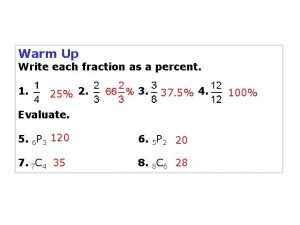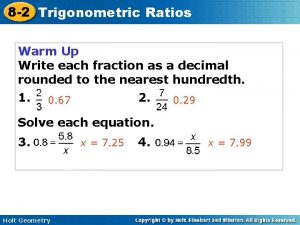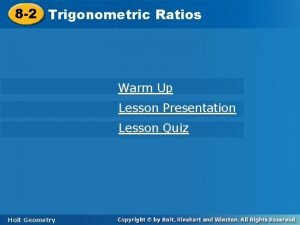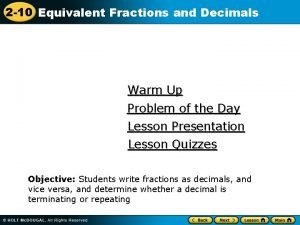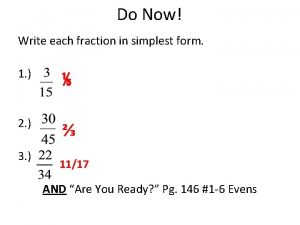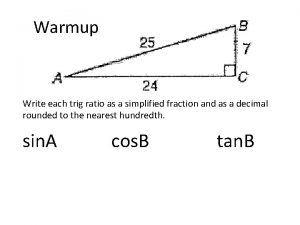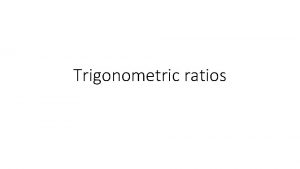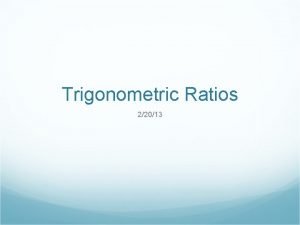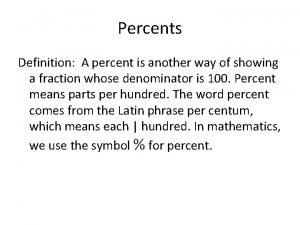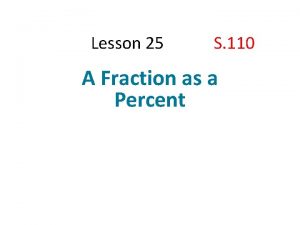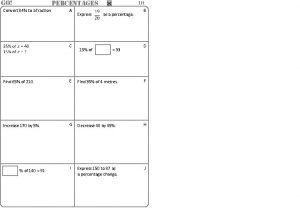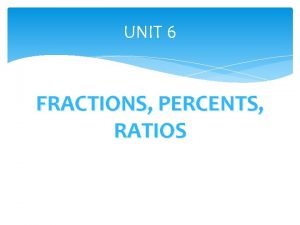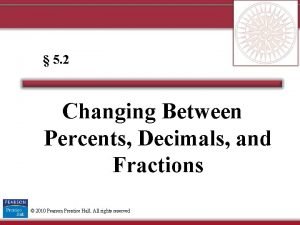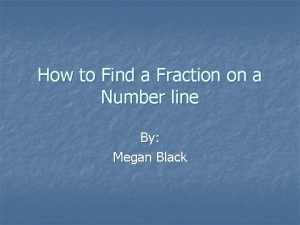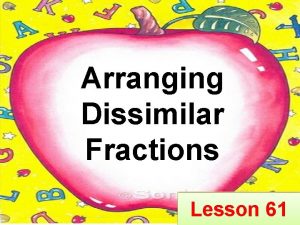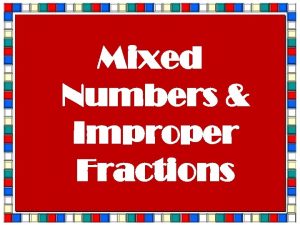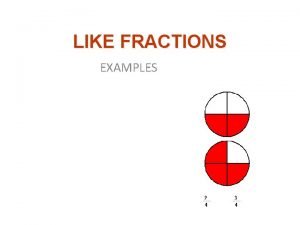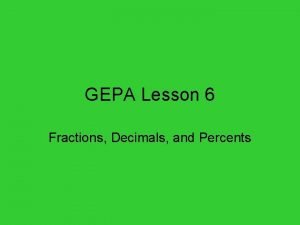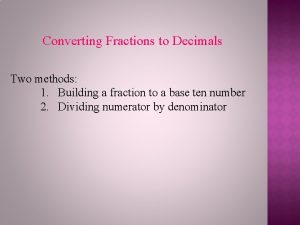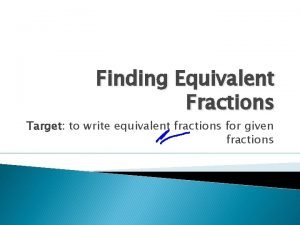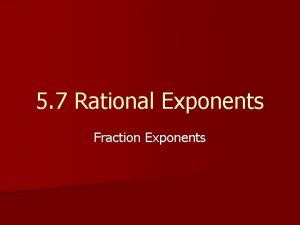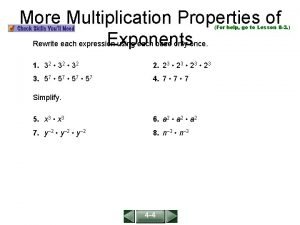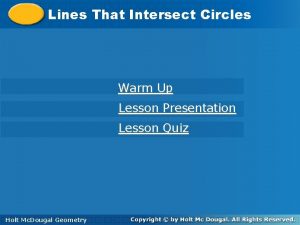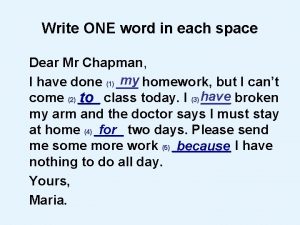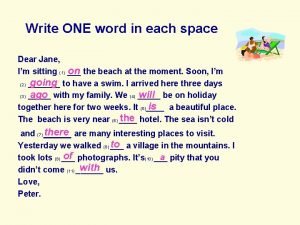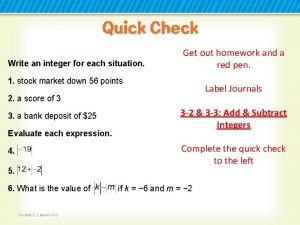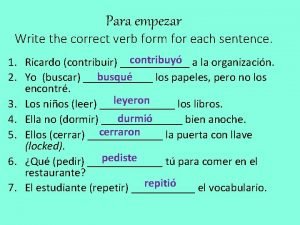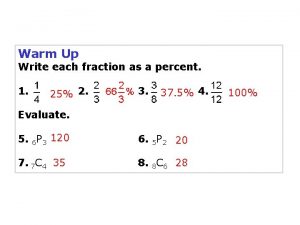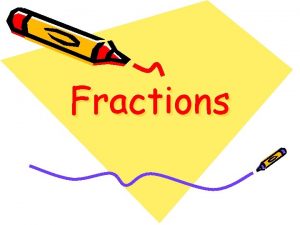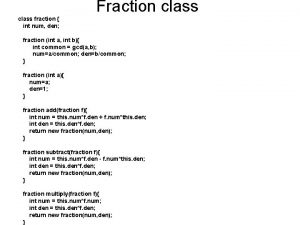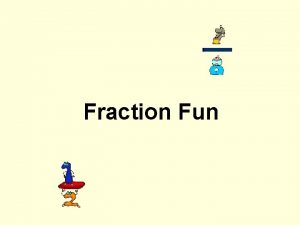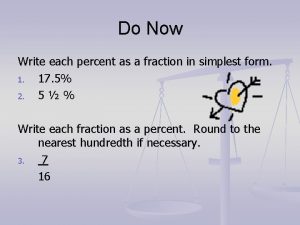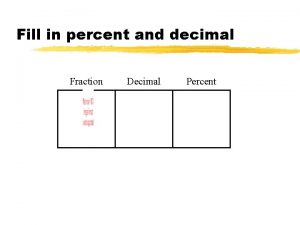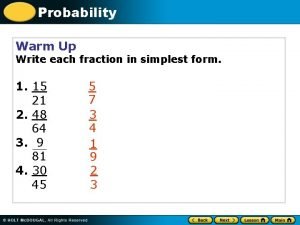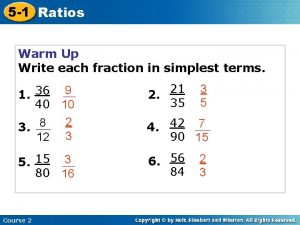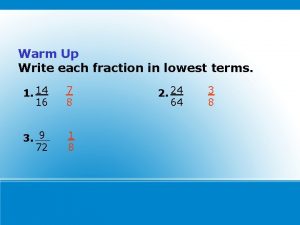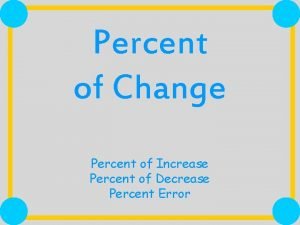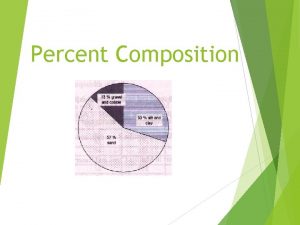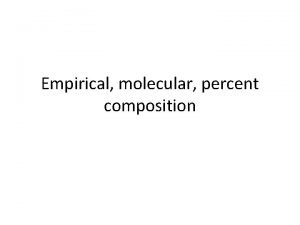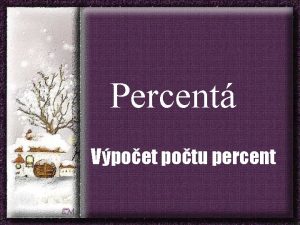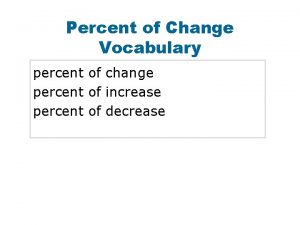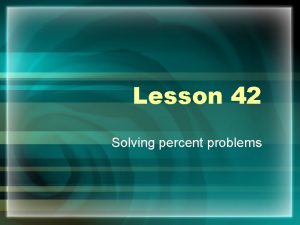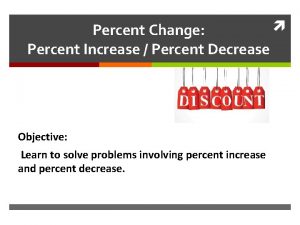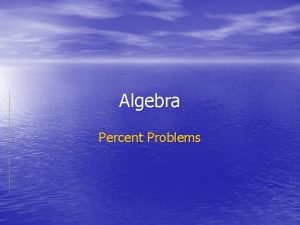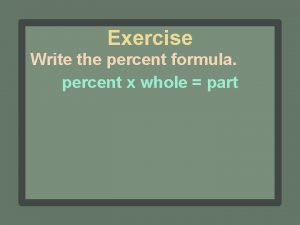Warm Up Write each fraction as a percent





























- Slides: 29

Warm Up Write each fraction as a percent. 1. 25% 2. 37. 5% 4. Evaluate. 5. 6 P 3 120 6. 5 P 2 20 7. 7 C 4 35 8. 8 C 6 28 100%

Probability is the measure of how likely an event is to occur. Each possible result of a probability experiment or situation is an outcome. The sample space is the set of all possible outcomes. An event is an outcome or set of outcomes.

Probabilities are written as fractions or decimals from 0 to 1, or as percents from 0% to 100%.

Equally likely outcomes have the same chance of occurring. When you toss a fair coin, heads and tails are equally likely outcomes. Favorable outcomes are outcomes in a specified event. For equally likely outcomes, theoretical probability of an event is the ratio of the number of favorable outcomes to the total number of outcomes.

Example 1 A: Finding Theoretical Probability Each letter of the word PROBABLE is written on a separate card. The cards are placed face down and mixed up. What is the probability that a randomly selected card has a consonant? There are 8 possible outcomes and 5 favorable outcomes.

Example 1 B: Finding Theoretical Probability Two number cubes are rolled. What is the probability that the difference between the two numbers is 4? There are 36 possible outcomes. 4 outcomes with a difference of 4: (1, 5), (2, 6), (5, 1), and (6, 2)

Check It Out! Example 1 a A red number cube and a blue number cube are rolled. If all numbers are equally likely, what is the probability of the event? The sum is 6. There are 36 possible outcomes. 5 outcomes with a sum of 6: (1, 5), (2, 4), (3, 3), (4, 2) and (5, 1)

Check It Out! Example 1 b A red number cube and a blue number cube are rolled. If all numbers are equally likely, what is the probability of the event? The difference is 6. There are 36 possible outcomes. 0 outcomes with a difference of 6

Check It Out! Example 1 c A red number cube and a blue number cube are rolled. If all numbers are equally likely, what is the probability of the event? The red cube is greater. There are 36 possible outcomes. 15 outcomes with a red greater than blue: (2, 1), (3, 1), (4, 1), (5, 1), (6, 1), (3, 2), (4, 2), (5, 2), (6, 2), (4, 3), (5, 3), (6, 3), (5, 4), (6, 4) and (6, 5).

The sum of all probabilities in the sample space is 1. The complement of an event E is the set of all outcomes in the sample space that are not in E.

Example 2: Application There are 25 students in study hall. The table shows the number of students who are studying a foreign language. What is the probability that a randomly selected student is not studying a foreign language? Language Number French 6 Spanish 12 Japanese 3

Example 2 Continued P(not foreign) = 1 – P(foreign) Use the complement. There are 21 students studying a foreign language. , or 16% There is a 16% chance that the selected student is not studying a foreign language.

Check It Out! Example 2 Two integers from 1 to 10 are randomly selected. The same number may be chosen twice. What is the probability that both numbers are less than 9? P(number < 9) = 1 – P(number 9) Use the complement. The probability that both numbers are less than 9, is

Example 3: Finding Probability with Permutations or Combinations Each student receives a 5 -digit locker combination. What is the probability of receiving a combination with all odd digits? Step 1 Determine whether the code is a permutation or a combination. Order is important, so it is a permutation.

Example 3 Continued Step 2 Find the number of outcomes in the sample space. number number 10 10 10 = 100, 000 There are 100, 000 outcomes.

Example 3 Continued Step 3 Find the number of favorable outcomes. odd odd odd 5 5 5 = 3125 There are 3125 favorable outcomes.

Example 3 Continued Step 4 Find the probability. The probability that a combination would have only odd digits is

Check It Out! Example 3 A DJ randomly selects 2 of 8 ads to play before her show. Two of the ads are by a local retailer. What is the probability that she will play both of the retailer’s ads before her show? Step 1 Determine whether the code is a permutation or a combination. Order is not important, so it is a combination.

Check It Out! Example 3 Continued Step 2 Find the number of outcomes in the sample space. n = 8 and r = 2 Divide out common factors. 4 = 28 1

Check It Out! Example 3 Continued Step 3 Find the number of favorable outcomes. The favorable outcome is playing both local ads before the show. There is 1 favorable outcome.

Check It Out! Example 3 Continued Step 4 Find the probability. The probability that a combination would have only odd digits is

You can estimate the probability of an event by using data, or by experiment. For example, if a doctor states that an operation “has an 80% probability of success, ” 80% is an estimate of probability based on similar case histories. Each repetition of an experiment is a trial. The sample space of an experiment is the set of all possible outcomes. The experimental probability of an event is the ratio of the number of times that the event occurs, the frequency, to the number of trials.

Experimental probability is often used to estimate theoretical probability and to make predictions.

Example 5 A: Finding Experimental Probability The table shows the results of a spinner experiment. Find the experimental probability. Number Occurrences 1 6 2 11 3 19 4 14 spinning a 4 The outcome of 4 occurred 14 times out of 50 trials.

Example 5 B: Finding Experimental Probability The table shows the results of a spinner experiment. Find the experimental probability. Number Occurrences 1 6 2 11 3 19 4 14 spinning a number greater than 2 The numbers 3 and 4 are greater than 2. 3 occurred 19 times and 4 occurred 14 times.

Check It Out! Example 5 a The table shows the results of choosing one card from a deck of cards, recording the suit, and then replacing the card. Find the experimental probability of choosing a diamond. The outcome of diamonds occurred 9 of 26 times.

Check It Out! Example 5 b The table shows the results of choosing one card from a deck of cards, recording the suit, and then replacing the card. Find the experimental probability of choosing a card that is not a club. Use the complement.

Lesson Quiz: Part I 1. In a box of 25 switches, 3 are defective. What is the probability of randomly selecting a switch that is not defective? 2. There are 12 E’s among the 100 tiles in Scrabble. What is the probability of selecting all 4 E’s when selecting 4 tiles?

Lesson Quiz: Part II 3. The table shows the results of rolling a die with unequal faces. Find the experimental probability of rolling 1 or 6.
 What is written
What is written Write each fraction as a decimal
Write each fraction as a decimal 8-2 trigonometric ratios answers
8-2 trigonometric ratios answers Equivalent of 2/10
Equivalent of 2/10 Simplest form definition
Simplest form definition Write each trigonometric ratio as a simplified fraction
Write each trigonometric ratio as a simplified fraction Zishyp
Zishyp Trigonometric ratios as fractions
Trigonometric ratios as fractions Valid percent and cumulative percent
Valid percent and cumulative percent Percent means
Percent means Lesson 25 a fraction as a percent
Lesson 25 a fraction as a percent 84 percent as a fraction
84 percent as a fraction Fractions amp; decimals quick quizzes ages 7 9 download
Fractions amp; decimals quick quizzes ages 7 9 download 165 as a mixed number
165 as a mixed number A percent is a fraction whose denominator is 100
A percent is a fraction whose denominator is 100 How do you find a fraction of a number
How do you find a fraction of a number Fraction na katumbas ng 5/6
Fraction na katumbas ng 5/6 1/4 fraction
1/4 fraction Like fractions example
Like fractions example Shade 7 hundredths and write the portion as a percent
Shade 7 hundredths and write the portion as a percent Write the ratio as a percent. 160:400
Write the ratio as a percent. 160:400 Equivalent fractions
Equivalent fractions How to write fraction exponents in radical form
How to write fraction exponents in radical form More multiplication properties of exponents
More multiplication properties of exponents Identify each line or segment that intersects each circle
Identify each line or segment that intersects each circle Complete the text. write one word in each space
Complete the text. write one word in each space Complete this letter write one word for each space
Complete this letter write one word for each space Write an integer for each situation worksheet
Write an integer for each situation worksheet Examine the picture carefully
Examine the picture carefully The correct verb form
The correct verb form
